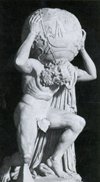Abstract from the American Astronomical Society meeting in San Diego, California, for talk 44.02 on 10 January 2005 - PDF
DISCOVERY OF THE LOST STAR CATALOG OF HIPPARCHUS ON THE FARNESE ATLAS
Bradley E. Schaefer (Louisiana State University)
Hipparchus was the greatest astronomer in Antiquity, with part of his reputation being based on his creation of the first star catalog around 129 BC. His star catalog has been since lost, although a few partial star positions are recorded in his only surviving work, the Commentary. Independently, a late Roman statue called the Farnese Atlas (now in Naples) has been known since the Middle Ages which records ancient Greek constellations. This marble statue shows the Titan Atlas kneeling on one knee while hold a large globe (65 cm in diameter) on one shoulder. This globe records 41 constellations accurately placed against a grid of reference circles, including the equator, tropics, colures, Arctic circle, and Antarctic circle. As the constellation positions shift over time (due to precession as discovered by Hipparchus), the position of the constellations on the Titan's globe will reveal the date of observations as ultimately used by the sculptor. Prior brief work on the globe has resulted in dates spread out over six centuries, with recent reviews only concluding that a thorough study is desperately needed. To fill this need, I have taken photographs appropriate for photogrammetry and have measured the positions of 70 points in the constellation figures and transformed these into RA and DEC in the globe's reference frame. A chisquare analysis then shows the date of the constellations to be 125 BC with a one-sigma uncertainty of 55 years. This date points directly at Hipparchus as being the observer and it strongly excludes all candidates that have been proposed over the past century (Aratus at c. 275 BC, Eudoxus at c. 366 BC, the original Assyrian observer at c. 1130 BC, and Ptolemy at AD 128). In addition, a very detailed comparison of the constellation figures and symbols on the Atlas' globe has been made with Hipparchus' Commentary, Aratus' (and Eudoxus') Phaenomena, Eratosthenes' Catasterismi, and Ptolemy's Almagest. I find essentially perfect agreement with Hipparchus' description of the sky (including many points unique to Hipparchus) with the Farnese Atlas; while all other ancient sources have many significant differences. In all, I have the very confident conclusion that the constellation figures on the Farnese Atlas are a depiction of Hipparchus' lost star catalog.
Photo credit: Dr. Gerry Picus, courtesy Griffith Observatory
 → TIFF [200dpi - 384 width/700 height (pixels)]
→ TIFF [200dpi - 384 width/700 height (pixels)]
→ TIFF [100dpi - 192 width/350 height (pixels)]
→ JPEG [100dpi - 192 width/350 hight (pixels)]
 → TIFF [300dpi - 2700 width/1800 height (pixels)]
→ TIFF [300dpi - 2700 width/1800 height (pixels)]
→ TIFF [300dpi - 1800 width/1200 height (pixels)]
→ JPEG [100dpi - 640 width/427 hight (pixels)]
Farnese Atlas - Back View
 → TIFF [300dpi - 2700 width/1800 height (pixels)]
→ TIFF [300dpi - 2700 width/1800 height (pixels)]
→ TIFF [300dpi - 1800 width/1200 height (pixels)]
→ JPEG [100dpi - 640 width/427 hight (pixels)]
PRESS RELEASE
Press Release - 11:00 A.M. PST, Tuesday, January 11, 2005, coordinated with a Press Conference at the American Astronomical Society meeting in San Diego, CA. -
PDF
PRESENTATION FOR PRESS
- Presentation - PowerPoint
- Precession Movie - Precession Movie (fast)
This movie shows how precession makes the stars and constellations slide along the ecliptic over the centuries. Compare the position of the Ram's horn being exactly on the meridian line (the colure) on the back view of the Farnese Atlas with the date around 125 BC when the Ram's horn actually was at the same position. [Note that the Atlas picture is looking at the sky from the 'outside', whereas the movie shows the sky as from Earth from the 'inside', causing the comparison between the two to be flipped left-right.] This is the essence of the dating technique used by Schaefer, although a total of seventy positions were used for the full mathematical analysis.
RESEARCH PUBLICATION
This paper is now in press for the May 2005 issue of the Journal for the History of Astronomy.
JHA, xxxvi (2005)
THE EPOCH OF THE CONSTELLATIONS ON THE FARNESE ATLAS AND THEIR ORIGIN IN HIPPARCHUS'S LOST CATALOGUE → PDF
0021-8286/05/3602-0000/$10.00 © 2005 Science History Publication Ltd